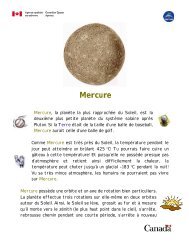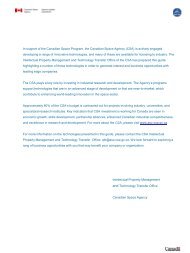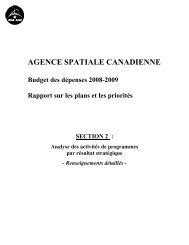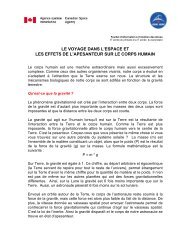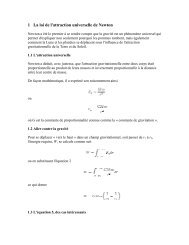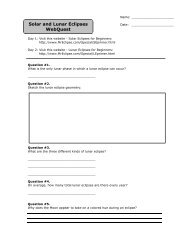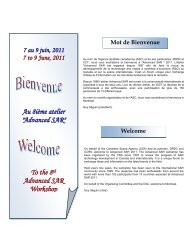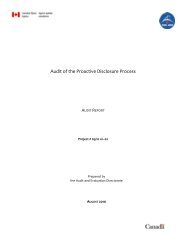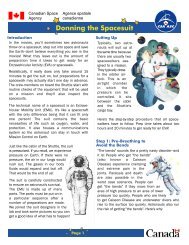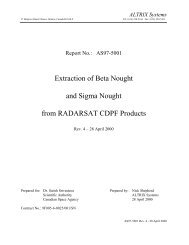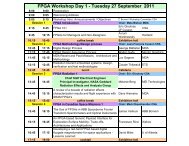PDF version of COSPAR - Space Science Research in Canada Report
PDF version of COSPAR - Space Science Research in Canada Report
PDF version of COSPAR - Space Science Research in Canada Report
Create successful ePaper yourself
Turn your PDF publications into a flip-book with our unique Google optimized e-Paper software.
Earth’s magnetosphere. In February 2007, NASA launched five small satellites toobserve the aurora from above. Meanwhile, Canadian researchers are us<strong>in</strong>g anetwork <strong>of</strong> ground stations to take images <strong>of</strong> the aurora every three seconds.These data are be<strong>in</strong>g coord<strong>in</strong>ated with the measurements taken by the satellitesto provide a comprehensive look at dynamic events occurr<strong>in</strong>g <strong>in</strong> the aurora.Themis has already captured data on one large substorm with an amount <strong>of</strong>energy equivalent to a magnitude 5.5 earthquake that crossed the entire polarzone <strong>in</strong> a mere 60 seconds. THEMIS has revealed previously unknown magnetic“ropes” that l<strong>in</strong>k the sun with the Earth’s upper atmosphere and provide aconduit—essentially a superhighway—for the solar w<strong>in</strong>d particles that power theauroras and geomagnetic storms. These and other f<strong>in</strong>d<strong>in</strong>gs from the THEMISproject will contribute to <strong>in</strong>creased understand<strong>in</strong>g <strong>of</strong> space weather and itseffects on Earth.<strong>Canada</strong> is uniquely well positioned to participate <strong>in</strong> this study because it hasmost <strong>of</strong> the landmass underneath the auroras and has a long history <strong>of</strong> auroralresearch. Sixteen <strong>of</strong> the 20 ground stations are located <strong>in</strong> <strong>Canada</strong>, with therema<strong>in</strong><strong>in</strong>g four <strong>in</strong> Alaska. Because they produce an unprecedented flood <strong>of</strong><strong>in</strong>formation, the Canadian science team, led by Eric Donovan <strong>of</strong> the University <strong>of</strong>Calgary, developed a new s<strong>of</strong>tware program called GAIA -- Global AuroralImag<strong>in</strong>g Access -- to manage the enormous amounts <strong>of</strong> data.In return for their contributions to the project, Canadian researchers participate <strong>in</strong>the THEMIS science team and ga<strong>in</strong> access to the data collected by the satellites.The Outer Radiation Belt Injection, Transport, Acceleration, and LossSatellite (ORBITALS)ORBITALS, which is currently <strong>in</strong> the advanced study phase, <strong>in</strong>volves thedevelopment <strong>of</strong> a new Canadian small satellite that will carry <strong>in</strong>struments to mapand study changes <strong>in</strong> the Van Allen radiation belts surround<strong>in</strong>g Earth. Scientistsbelieve this region <strong>of</strong> the Earth’s magnetosphere has been under-explored andthat it’s important to ga<strong>in</strong> a better understand<strong>in</strong>g <strong>of</strong> the conditions there for bothscientific and practical reasons. Intense radiation <strong>in</strong> this region, which can beamplified by outbursts <strong>of</strong> charged particles from the sun, can damage satellitesand other spacecraft. Because <strong>of</strong> the height <strong>of</strong> their orbits, geosynchronoussatellites used for global communications are particularly vulnerable to suchradiation.ORBITALS is <strong>in</strong>tended as a contribution to the satellite <strong>in</strong>frastructure for theInternational Liv<strong>in</strong>g With a Star (ILWS) program, which focuses on improv<strong>in</strong>gscientific understand<strong>in</strong>g <strong>of</strong> space weather, disturbances <strong>in</strong> near-Earth space19



